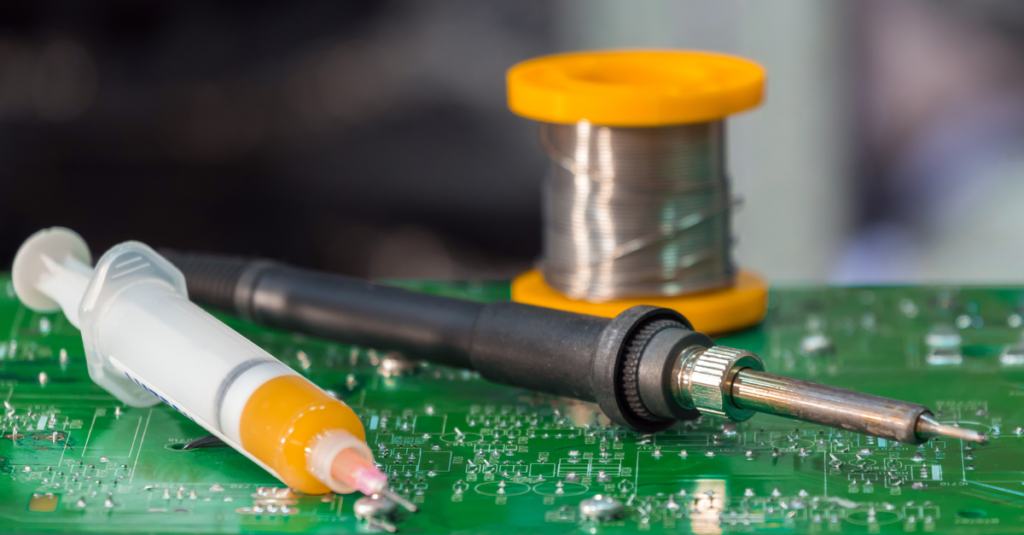
Aluminium soldering flux is a type of flux specifically formulated for the soft soldering of aluminium. Aluminium soldering flux is an organic, reactive flux that effectively removes the oxide film and allows aluminium to be soldered in a single operation without the need for abrading the surface prior to soldering.
In this article, we will explore the question “How to make aluminium soldering flux?”
- How to make aluminium soldering flux?
- what are some common applications of aluminum soldering flux?
- what are the advantages of using aluminum soldering flux over other types of flux?
- what are some alternatives to aluminum soldering flux?
- what are the advantages and disadvantages of using iron/torch for soldering aluminum?
- what are some common types of aluminum soldering flux?
- Helpful Resources
How to make aluminium soldering flux?
To make aluminum soldering flux, you will need the following materials and tools:
Materials:
- 25g of Potassium Fluoride (KF)
- 25g of Ammonium Chloride (NH4Cl)
- Borax Powder
Tools:
- Glass Container
- Spoon for Stirring
Step-by-Step Guide:
1. Prepare the Glass Container: Ensure the glass container is clean and dry before use.
2. Add Potassium Fluoride (KF): Measure and add 25g of Potassium Fluoride into the glass container.
3. Add Ammonium Chloride (NH4Cl): Measure and add 25g of Ammonium Chloride into the glass container.
4. Stir the Ingredients: Use the spoon to thoroughly combine the Potassium Fluoride and Ammonium Chloride until they are well mixed.
5. Add Borax Powder: Optionally, you can add a small amount of Borax Powder to the mixture. Borax can help improve the flow of the solder and reduce surface tension.
6. Store the Flux: Once the flux is thoroughly mixed, it is ready for use. Store the finished flux in a cool, dry place away from direct sunlight to prevent degradation over time.
Safety Precautions:
1. When handling these chemicals, use safety gloves and goggles throughout the process, as they can be corrosive if not appropriately handled.
2. Store the finished product in a cool, dry place away from direct sunlight, as exposure can cause it to degrade over time.
By following these steps, you can make your own aluminum soldering flux at home. Always remember to handle the chemicals with care and follow appropriate safety measures.
what are some common applications of aluminum soldering flux?
Aluminum soldering flux is used in various applications to facilitate the soldering of aluminum and its alloys. Some common applications of aluminum soldering flux include:
1. Automotive Industry: Aluminum soldering flux is used in the automotive industry to join aluminum components in cars and trucks, such as heat exchangers, radiators, and air conditioning systems. Its lightweight nature and corrosion resistance make it an ideal choice for these applications.
2. Aerospace Industry: In the aerospace industry, aluminum soldering flux is used for joining aluminum components in aircraft and spacecraft. Its ability to create strong and reliable bonds makes it suitable for critical aerospace applications.
3. Electronics and Electrical Engineering: Aluminum soldering flux is used in electronics and electrical engineering for soldering aluminum components in various devices and equipment. It helps create durable and reliable connections in electronic circuits and systems.
4. General Fabrication and Repair: Aluminum soldering flux is used in general fabrication and repair work, where aluminum components need to be joined or repaired. It is commonly used in metalworking, plumbing, and other fabrication and repair applications.
5. Other Metal Joining Applications: In addition to aluminum, the flux can also be used to join other metals such as stainless steel, nickel, copper, and various other metals. This makes the flux a versatile solution for a wide range of metal joining applications.
These applications demonstrate the versatility and importance of aluminum soldering flux in various industries and manufacturing processes. The flux plays a critical role in enabling the soldering of aluminum and its alloys, allowing for the creation of strong and durable metal joints in a wide range of applications.
what are the advantages of using aluminum soldering flux over other types of flux?
The advantages of using aluminum soldering flux over other types of flux include:
1. Oxide Removal: Aluminum forms a stable oxide layer on its surface, which can hinder the soldering process. Aluminum soldering flux is specifically formulated to remove this oxide layer, ensuring a strong and reliable bond.
2. Corrosion Resistance: Aluminum soldering flux helps create corrosion-resistant joints, providing long-lasting and durable bonds in various environments. This property is particularly beneficial in industries that require components to withstand harsh conditions.
3. Lightweight: Aluminum solder is lighter than other solders, such as lead-based solder. This makes it an excellent choice for industries where weight reduction is crucial, such as automotive and aerospace applications.
4. Versatility: Aluminum soldering flux can be used for a wide range of metal joining applications, including stainless steel, nickel, copper, and various other metals. This versatility makes it a valuable solution for diverse manufacturing processes.
5. Improved Spreading of Solder: Aluminum soldering flux improves the spreading of solder, which in turn enhances the quality and density of metal connections. This is essential for creating strong and reliable joints in various applications.
6. Ease of Application: Aluminum soldering flux is available in various forms, such as paste, liquid, and flux-cored wire, making it easy to apply and suitable for different soldering techniques and processes.
In summary, the use of aluminum soldering flux offers several advantages, including its ability to remove oxide layers, provide corrosion resistance, and create lightweight and durable bonds. These properties make it a preferred choice for a wide range of industrial and manufacturing applications.
what are some alternatives to aluminum soldering flux?
Some alternatives to aluminum soldering flux include:
1. Acid Flux: Acid flux, such as chloride-based flux, is effective for soldering almost all metals, excluding aluminum and magnesium. However, it has several significant disadvantages, including being highly corrosive and not suitable for use with aluminum.
2. Zincate Layer: Another alternative for soldering to aluminum is to coat the aluminum with an ultrathin zincate layer. This process involves dissolving zinc in a solution, dipping the part to coat it with zinc, and then drying it before soldering. The zinc layer helps improve the adhesion of the solder to the aluminum surface.
3. Specialized Flux for Stainless Steel: When soldering stainless steel, specialized fluxes designed for stainless steel applications can be used. These fluxes are formulated to work specifically with stainless steel and can help improve the adhesion of solder to the stainless steel surface.
4. Universal Flux: There are universal fluxes available that can be used for a wide range of metal joining applications, including stainless steel, nickel, copper, and various other metals. These fluxes are designed to be versatile and can be a reliable option for various soldering and brazing applications.
It’s important to select the appropriate flux for the specific metal and application to ensure successful soldering. Each type of flux has its own advantages and limitations, and the choice of flux should be based on the specific requirements of the soldering process.
what are the advantages and disadvantages of using iron/torch for soldering aluminum?
The use of an iron or torch for soldering aluminum offers both advantages and disadvantages. Here are the details:
Advantages:
1. Higher Temperature: A torch can provide the higher temperatures required for aluminum soldering, as aluminum has a higher melting point compared to other metals commonly soldered with a soldering iron.
2. Effective Heat Transfer: A torch can overcome the heat loss due to aluminum’s high thermal conductivity, ensuring that the aluminum reaches the necessary temperature for soldering.
3. Versatility: Torches can be used for a wide range of metal joining applications, providing a versatile solution for various soldering and brazing processes.
Disadvantages:
1. Oxide Formation: Aluminum forms a stable oxide layer on its surface, which can hinder the soldering process. The use of a torch may not effectively address this challenge, requiring proper surface preparation and flux application.
2. Thermal Expansion: Aluminum has a higher coefficient of thermal expansion than other metals, which can lead to stress and potential failure of the joint. Careful control of the heating process is required to avoid these issues.
3. Corrosive Flux: Some torch-based soldering processes may involve the use of corrosive flux, which requires careful handling and post-soldering cleaning to prevent long-term corrosion issues.
In summary, while a torch can provide the high temperatures necessary for soldering aluminum, it also presents challenges related to oxide formation, thermal expansion, and the use of corrosive flux. Careful surface preparation, flux application, and heat control are essential when using a torch for soldering aluminum to ensure successful and durable joints.
what are some common types of aluminum soldering flux?
Some common types of aluminum soldering flux include:
1. Organic Flux: Organic flux is a popular choice for soldering aluminum. It is less corrosive than acid flux and easier to remove from the soldered joints. Organic fluxes are also biodegradable if stored for a longer time.
2. Rosin Flux: Rosin flux is specifically designed for microelectronics applications. It has a special molecular structure that makes it non-corrosive and non-conductive, making it ideal for soldering electronic contacts.
3. Aluminum Soldering Paste: Aluminum soldering paste is a convenient form of flux that allows for precise placement on the metal surface. It is typically used with a needle to dispense the paste onto the metal.
4. Flux-Cored Soldering Filler Metal: This type of flux is incorporated into the filler metal, creating a higher viscosity and solid content. When heated, it turns into a liquid form and can be dispensed onto the metal surface using an injector.
5. Liquid Flux and Solder: Liquid flux and solder are commonly used for soldering aluminum. They provide a more traditional method of applying flux and solder to the metal surface.
6. Paste Flux and Solder: Paste flux and solder are another convenient form of flux that allows for precise placement on the metal surface. They are typically used with a needle to dispense the paste onto the metal.
It’s essential to note that not all soldering fluxes are suitable for aluminum. Acid flux, for example, is highly corrosive and not recommended for soldering aluminum. Always use a flux that is specifically formulated for aluminum to ensure successful and durable joints.
Helpful Resources
- https://www.electricity-magnetism.org/aluminum-solder/
- https://www.electronicshub.org/soldering-aluminum/
- https://www.diyaudio.com/community/threads/soldering-aluminium.197412/
- https://www.youtube.com/watch?v=x3a0Tdi6060&t=60
- https://superiorflux.com/products/aluminum-flux/
- https://scienceprog.com/reliable-soldering-with-fluxes/
- https://www.reddit.com/r/soldering/comments/10pxlpt/flux_optionsalternatives_for_stainless_steel/
- https://en.wikipedia.org/wiki/Soldering
- https://www.linkedin.com/pulse/soldering-salman-cader
- https://thecorrecter.com/how-to-solder-aluminum-wire-for-jewelry/
- https://thecorrecter.com/how-to-polish-pitted-aluminium-wheels/
- https://thecorrecter.com/how-to-strip-and-refinish-aluminum-wheels/
- https://thecorrecter.com/how-to-clean-corroded-aluminium-wheels/
- https://thecorrecter.com/how-to-hard-anodize-aluminium/
- https://thecorrecter.com/how-to-anodize-aluminium-at-home/
- https://thecorrecter.com/how-to-artificially-age-aluminium/
- https://thecorrecter.com/how-to-darken-aluminium/
- https://thecorrecter.com/do-aluminium-boats-need-anodes/
- https://thecorrecter.com/does-aluminium-corrode-in-water/
- https://thecorrecter.com/how-to-remove-oxidation-from-aluminium-engine/
- https://thecorrecter.com/how-to-stop-electrolysis-on-aluminium-boat/
